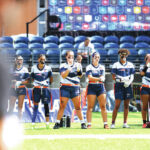Why flag football’s Olympics inclusion has been ‘rocket fuel’ for growth, especially among women


LAS VEGAS — Maci Joncich sat in the bleachers at Coronado High School’s football stadium in April, her future in football crystallizing.
Joncich, 17, had recently become the youngest player to make the U.S. women’s national flag football team. Only four years prior, her options in the sport were slim.
“The biggest point of discussion was, ‘What comes next with flag football?’” Joncich said. “When I started, there was no flag in college. There were no Olympics. It was a bit of a struggle at first just getting the motivation to keep playing.”
All that has changed because of the expeditious rise of the sport.
There are now 11 states in which flag football is recognized as a girls’ varsity high school sport. Women’s flag football scholarships are offered at 25 National Association of Intercollegiate Athletics colleges.
There are not many options for boys or men beyond the club level, but there will soon be a professional option. The American Flag Football League plans to begin men’s and women’s leagues in 2025. And in perhaps the biggest news for the sport in the United States, flag football will become an Olympic sport in 2028, when the Summer Games return to Los Angeles.
According to USA Football, the governing body of American football in the United States, more than 230,000 girls ages 6 to 17 played flag football in the United States in 2023, a 44% increase from 2014. Including boys, there were more than 1.6 million American youths playing flag football as of 2023. The sport is played in 100 countries.
The NFL has also invested in flag football. In May, the league hired Stephanie Kwok as its first vice president for flag football. The league hopes the sport’s growth will increase the number of women who watch and play the sport.
“All of a sudden, you see these opportunities to compete at the highest level,” Kwok said. “With the popularity of the WNBA right now and professional women’s sports as a whole, I think it’s really interesting to be thinking about what other opportunities there could be.”
She added: “They can see in a more real way what you can aspire to do knowing that there’s a path to the Olympics.”
A path for women like Joncich. After making USA Football’s final 12-player roster in June, Joncich would like to represent the United States in the 2028 Los Angeles Games. While she is not guaranteed a spot on the team, she has a road map to follow.
“Before the Olympics, there hasn’t been a North Star for girls who participate in football,” said Sam Rapoport, NFL senior director for diversity, equity and inclusion. “And so when you create that North Star, then there’s a flag pipeline for girls.”
Joncich said: “It creates a pathway for people. Not only for me, but for a lot of women.”
Brianna Hernandez-Silva had a winding path to flag football. She was a longtime baseball and softball player before a coach at Bonanza High School in Las Vegas persuaded her to join the flag football team.
“I gave it a shot,” Hernandez-Silva said. “And it was probably the best decision I ever made.”
Florida was the first state to recognize girls’ flag football as a varsity high school sport, in 2003, but it took time to catch on elsewhere. It was not until 2015 that Nevada became the second.
There were still no college scholarships for flag football when Hernandez-Silva graduated in 2018, so she attended the College of Southern Nevada, where she played softball. But when the NAIA added flag football in 2020, she transferred the next year to Kansas Wesleyan University to pursue it. Three years later, the defensive back and quarterback was named an alternate for the 2024 U.S. women’s national flag team.
“The game itself has grown so much,” she said.
As a girl, Kwok wanted to play organized football. Her only option in high school, however, was playing pickup football with friends. She went on to play intramural touch football at Stanford and had her first flag football experience on an intramural team at Harvard Business School.
When she graduated and moved back to New York, she brought her newfound hobby with her. Over the next 10 years, she played in flag football leagues multiple times a week. She co-founded Pickup Football, an adult flag football tournament, and helped run it until the pandemic in 2020. In her new role with the NFL, she hopes to provide an avenue for girls and boys to play the sport and avoid having to wait as long as she did.
“There weren’t opportunities for me to play growing up,” Kwok said. “Now, I get to help shape how we increase accessibility.”
Kwok runs NFL FLAG, the league’s official flag football program. All 32 NFL teams participate, and the broad focus is on providing opportunities for athletes ages 4 to 17. The organization has more than 600,000 participants and teams in all 50 states.
“I want everyone who wants to play flag football at every level to be able to do that,” Kwok said. “It’s just making sure they have that access and opportunity no matter who they are at every level of the game.”
The reasons for the NFL’s effort to grow flag football are multifaceted. Flag provides a safer alternative to tackle football. For youth athletes, it is a way to learn the fundamentals of the sport without the high risk of injury.
For Joncich, that process started when she joined the Apex Predators, a youth flag football club in Las Vegas. On Sunday, in the 18-and-under girls’ NFL FLAG championship, Apex lost to the Staten Island Giants, 28-7, in Canton, Ohio, a game televised by ESPN.
Joncich joined the club because it provided exposure to coaches equipped to properly teach the sport. The club’s vice president, Todd Thomson, knows as well as anyone the key differences between the versions of football.
“To get on the field playing flag, you’ve got to have footwork,” Thomson said. “Obviously, in tackle, you’re working on blocking schemes, whereas in flag, you don’t have that. But the skill set, the athleticism, all the agility training that you do in flag directly translates over to tackle.”
While tackle football requires expensive equipment and 22 players, the only equipment needed in flag football is a football and flags, and it can be played in five-on-five and seven-on-seven formats. That makes it more widely accessible.
“This is the easiest, fastest and most cost-effective way to grow the sport,” said Scott Hallenbeck, who leads USA Football. “You can scale it very quickly. I think the NFL is already seeing that both drive fandom and just drive general participation.”
Several NFL players have expressed a desire to compete in the 2028 Olympics, but it will require a major adjustment for them. The NFL Pro Bowl shifted to a seven-on-seven flag football format in 2023, but it is not officiated as strictly as international competition.
“If there’s the slightest contact, they’ll call the defender for a penalty,” Hallenbeck said. “It’s to the point where I’m on the international federation board and I’m like, ‘Guys, we’ve got to loosen these rules up a little bit.’ I mean, fans aren’t going to enjoy literally no contact.”
The International Federation of American Football has 74 member nations, and that number is expected to increase before the 2028 Olympics.
While it can be assumed that the U.S. men’s and women’s teams will have a leg up on other countries less familiar with American football, there is still work to be done. Canada, Mexico, Panama and Brazil are examples of other countries with elite flag football programs that will be fierce competition.
“We’re talking about now creating world-class athletes,” Hallenbeck said. “Four years scares me to death because it’s not long enough, but our job is to get that ready.”
Despite the NFL’s efforts to grow the game internationally, football is still largely known as an American sport. But if the inclusion of flag football in the 2028 Olympics is a success, it can become a watershed moment for football’s worldwide presence.
The Olympics will put a spotlight on football in general, but especially for women.
“I refer to the announcement of the Olympics as rocket fuel,” Hallenbeck said. “It ignited something that was already burning and ready to take off. For a long time, girls have wanted to play football. They’ve done it here and there, but now the floodgates are truly open.”






